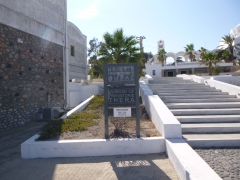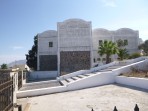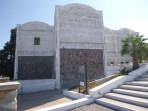Museum of Prehistoric Thera - Santorini

The capital of the Greek island of Santorini, Fira, is home to several museums and permanent exhibitions. One of these cultural buildings is the Prehistoric Thera Museum - a smaller museum, but one that houses many interesting and important exhibits.

The Prehistoric Thera Museum is housed in a modern, two-storey building in the capital city of Fira, and opened to the public in 2000. The patron and "spiritual father" of the museum is the famous Greek archaeologist Spyridon Marinatos. He led the excavations in the historical area of Akrotiri and sought to create a museum that could house the valuable finds from this archaeological site.
The exhibits on display at the Prehistoric Thera Museum come geographically from various locations around the island of Santorini. Most of these finds are linked to the aforementioned archaeological site of Akrotiri, but there are also artefacts from the Potamos site, for example, or small objects found by chance by locals in different parts of the island.
The Prehistoric Thera Museum is thus sometimes described as an "adjunct" to the Akrotiri archaeological site. Thanks to the excavations in the Akrotiri area, visitors can walk through a mature and well-preserved ancient city, while the most valuable finds from the site can then be viewed more closely in the museum in the capital, Fira. Among the museum's most important exhibits are clearly the frescoes and impressive murals from the public and private buildings of the ancient city. Because of the way these murals were kept, S. Marinatos came to believe that life in the ancient city of Akrotiri was significantly influenced by the so-called Minoan culture. The individual display cases also house tools, utensils, marble figurines, historical pottery, as well as beautiful and elaborate jewellery. However, not much jewellery has survived in this area, as it is believed that the townspeople were warned of the impending danger in advance and after the volcanic eruption, the ash and hot volcanic dust covered the empty town. However, the town remained perfectly preserved until its discovery in the second half of the 20th century.
The museum's other collections are arranged chronologically. The exhibits chart the history of Santorini from the late Neolithic period to the so-called Cycladic period. Most space is devoted to the period around the 18th and 17th centuries BC, when ancient Thera was one of the most important islands of the Aegean. The museum also possesses fossils of insects and plants that originated here before the arrival of the first inhabitants.
If you didn't miss a visit to the archaeological site of Akrotiri during your stay in Santorini, and if you enjoyed your time there, we recommend you also visit the Prehistoric Thera Museum, where you will see a large number of objects originating from this ancient city. Thanks to them, you can get a much better and more complete picture of life in Akrotiri.
More touristic destinations of Santorini
Tips for trips on Santorini: Caldera Boat Trip, Sunset in Oia, Most beautiful beaches of Santorini, Discovering the beauties of the capital city of Fira, Visiting Ancient Thera
Resorts, beaches, sights or trips - clearly listed on the map of Santorini.
Did you visit this place and do you have some additional informations, interessting observation or photos?


